In the temple kitchens of South India, each sacred offering tells a story steeped in centuries-old rituals and regional influences.

Madapallis are temple kitchens where the sacred temple offerings are prepared. (iStock)
Growing up in a household deeply rooted in faith, our regular visits to temples, both grand and humble, were always filled with anticipation. Among all the temples I frequented as a child, the 6th-century Parthasarathy Temple, where I often accompanied my grand aunt, held quite the magic.
With devotion, she would perform her prayers, making numerous rounds around the ancient structure, while I, a curious child, would lose myself in the intricate stone carvings adorning its walls. Yet, the true reward awaited me beyond the sanctum, in the temple’s madapalli, its sacred kitchen.
In those earlier days, the madapalli was a modest affair, tended to by just a pair of temple staff. Seated before bamboo baskets brimming with delights, they offered a humble yet sumptuous spread of prasadams. Puliyodharai, Sarkarai Pongal, Adirasam, Sojji appam, and Thenkuzhaal would invite me tantalisingly.
My personal favourites were the tangy puliyodharai and the sweet, delectable sojji appam. With practised hands, the temple staff would deftly package our selections in thonnais (dried leaves serving as rustic wrappers). Tying them securely with rope, they would hand over the parcels, ready to be savoured.
Total number of Hindu temples in every state of India (2022) pic.twitter.com/v4f1KtBHkG
— India in Pixels by Ashris (@indiainpixels) May 30, 2022
In a 2022 survey by Temples of India, a platform maintained by students of IIT Bombay, it was found that India is home to a staggering 6,48,907 temples, averaging 53 temples per one lakh persons.
In the southern region, which includes the five southern states, there are a total of 2,39,982 temples. Tamil Nadu particularly shines as the state with the highest number of temples, boasting an impressive tally of 79,157.
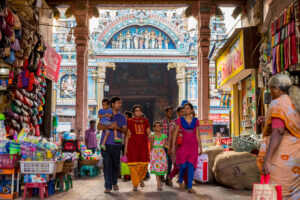
In south India, there are a total of 2,39,982 temples. (iStock)
In countless Hindu temples across South India, similar to my own memories, a visit typically concludes on a flavourful note. In many of these temples, you’ll find a kitchen known as the madapalli. Here, food is prepared as a neivedhyam (offering) to the temple’s main deity before it’s shared as a prasadam (sacred offering) with the worshippers.
It’s a captivating tradition, to say the least. Not only does it delight the palate with irresistible flavours, but for many, it also provides deep spiritual nourishment.
If you look into the historical context of madapallis, sacred texts like the Agama Sashtra provide intricate guidelines on how temples and their kitchens are to be consecrated. “It’s essentially a detailed manual, encompassing everything from worship rituals to offerings. The Agama Sastra serves as a comprehensive resource for all temple-related matters. One section specifically details the temple kitchen, including specifications on directions, utensils to be used, quality of ingredients, and even sourcing firewood,” explains food historian Rakesh Raghunathan.
Over the years, Raghunathan has been dedicated to documenting and raising awareness about South Indian temple food. But where did this passion originate? “It all began with the akkaraadisil,” he explains.
Akkaraadisil is a sweet made from milk, rice, and jaggery. This prasadam is famously mentioned in the Nachiyar Thirumozhi, a work by the Tamil saint-poet Andal dating back to the 9th-10th century.
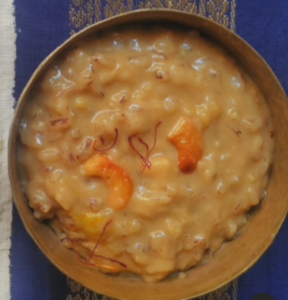
Akkaraadisil is a sweet made from milk, rice, and jaggery. (Rakesh Raghunathan)
In Andal’s verses, she fervently prays, promising to offer 100 pots of butter and akkaraadisil if the Lord at Srirangam agrees to marry her.
“For me, these verses and the prasadam were the perfect way to marry my singing and cooking. They sparked my journey into researching temple prasadams and led me from one discovery to another,” shares Raghunathan.
Even today, the Srivilliputhur Andal temple in Tamil Nadu, dedicated to the poet-saint, serves the akkaraadisil as the main offering.
The offerings in temple kitchens are often carefully selected based on various factors, one of which is the seasonal availability of ingredients and sensibilities.
“The Aadi month in Amman temples, and Rama Navami are perfect examples,” explains Raghunathan.
Both occasions fall during the scorching summer months.
“In the Aadi month, worshippers particularly devoted to Shakthi forms of worship, traditionally offer meat sacrifices sourced from their own rearing. They’re also known as custodians of millets. Therefore, dishes like raagi koozh, where the raagi is cooked, fermented and diluted with buttermilk and is served with drumstick leaf poriyal or karuvadu (salted dried fish). These provide cooling relief from the intense summer heat,” he shares.
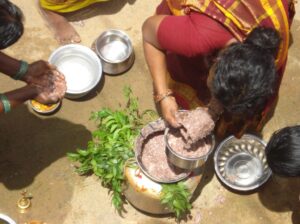
Raagi koozh: The raagi is cooked, fermented and diluted with buttermilk and is served with drumstick leaf poriyal or karuvadu. (Wikimedia)
Similarly, panagam, a sweet drink made from jaggery, elaichi, and sukku (dried ginger), made during Rama Navami helps to cool the body and is commonly served during hot seasons. This way certain prasadam offerings in temple kitchens are tailored to suit the seasons.
During the harvest festival of Pongal, for instance, rice-based prasadhams are prevalent in temples.
“Ultimately, temple prasadam reflects what people offer to the temple and what the temple, in turn, offers to the devotees,” Raghunathan shares, emphasising the reciprocal relationship between worshippers and temples in the sharing of temple offerings.
The other parameter is the region-specific produce which influences temple offerings.
“Unni appam is a classic offering found in Kerala temples. This traditional dish often features bits of coconut, a common ingredient abundant in Kerala cuisine. Similarly, jackfruit, another regional speciality, lends its unique essence to many prasadams, adding to the rich culinary heritage of the region,” Raghunathan elaborates.
Beyond the madapalli operations, there are occasions when the preparation of offerings becomes a communal effort.
“In Kerala, at the Attukal Bhagavathy Amman temple, there’s a festival called Pongala,” Raghunathan explains. “It holds the Guinness World Record for being the largest congregation of women. During this event, women prepare a delicacy called therali appam. It involves mixing rice flour with banana, jaggery, coconut and elaichi. It is shaped into balls between the fist and rolled between fresh cinnamon leaves before steaming. Although it’s not conducted in a madapalli setting, it’s a remarkable community-based activity,” shares Raghunathan.
During our conversation, Raghunathan shatters a common myth surrounding temple offerings — that they’re strictly vegetarian.
“There’s a misconception that temple prasadams are exclusively vegetarian. Even when I began my research, a lot was around the vegetarian prasadams. However, digging deeper, you realise there’s much more to it,” he shares.
“Take the Aadi month, for instance; ragi koozh comes with karuvadu. And in the Shakthi forms of worship, meat-based offerings are common,” he reiterates.
The temple kitchens across South India offer a diverse array of meat-based delicacies. From dried fish and toddy at the Parassinik Kadavu Temple in Kerala to mouthwatering meat biryani at the Muniyandi Swami Temple in Madurai, each temple tells a unique story. It adds layers of richness to our cultural heritage.
“When you interact with indigenous tribal communities, you understand their forms of worship. Their worship rituals centre around nature — sun, water sources, cattle, and local produce like fruits, millet, bananas, and jaggery. It’s fascinating,” he adds.
“I would think the Pazhani panjamirtham prasadham is probably influenced by the tribal communities that used to live in and around that region,” he ponders. “One of the offerings is thenum thinai maavum (honey and foxtail millet flour). This was extensively grown and cultivated by indigenous tribal communities in the region. You can only extrapolate and piece together the logical conclusion as to why this is offered,” he explains further.
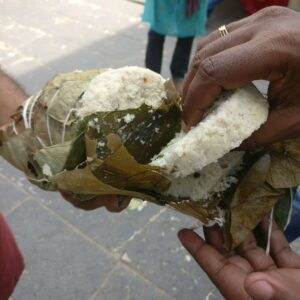
Kanchipuram idli — a rice cake, seasoned, and steamed in bamboo baskets. (Roshne Balasubramanian/South First)
Another intriguing offering found in temple kitchens is the dosai served at Madurai’s Azhagar Kovil. “In the South, rice and rice flour-based offerings are commonly used as a base. Azhagar Kovil’s dosai is a rustic preparation of the dish,” explains Raghunathan.
Author Shoba Narayan in her book Food and Faith: A Pilgrim’s Journey Through India, writes, “Azhagar temple prasadam includes piquant lemon rice, bright yellow and specked with black mustard seeds; tangy tamarind rice; sweet pongal flavoured with jaggery, cashew nuts, cardamom and tons of ghee. But the pride of place goes to the Azhagar Kovil dosai, famed in the area for its taste…The recipe is simple and boils down to one foolproof cooking technique: the dosai is deep-fried in ghee, giving it a richness and depth of flavour that no amount of healthy, low-cal cooking can replicate.”
Every temple boasts its unique prasadam, reflecting the local culture and traditions.
Take, for instance, the Kanchipuram Varadharaja Perumal temple in Tamil Nadu, where the prasadam is the famous Kanchipuram kudalai idli — a rice cake, seasoned, and steamed in bamboo flower baskets. “While the exact origin of this cannot be traced, if you look into literature, you’ll discover mentions of the region of Kanchi where the main idol was believed to be surrounded by a bamboo forest. It’s through these fragments of information that we piece together the story,” he explains.
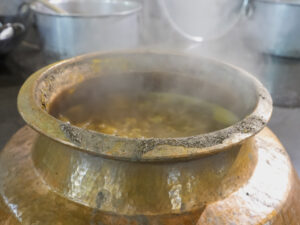
Diverse influences have shaped temple traditions and offerings. (iStock)
Various influences, including historical events, have moulded temple traditions and offerings over time. At the Srirangam temple, an intriguing prasadam is presented to Lord Ranganatha at midday — chapati and keerai kootu. Raghunathan explains, “This exemplifies the narrative of Tuluka Nachiyar — a Muslim princess who became a revered goddess in the Srirangam temple. As a tribute to her, the deity continues to receive chapati and keerai kootu offerings.”
In modern times, there’s been a noticeable shift in the operations of temple kitchens and the methods of preparing prasadams. Take, for example, the production of the GI-tagged Panchamirtham in Pazhani, which has now been automated. “With the ever-increasing demand, such advancements have become necessary to cater to the growing population and their needs. It’s simply impossible to manually prepare for such large crowds,” explains Raghunathan.
Moreover, there have been interesting additions to traditional prasadams, such as the incorporation of red chillies and tomatoes. “In the past, biryani was never considered a prasadam, but now it’s served as a temple offering. So, if the ways of worship have evolved, why shouldn’t the methods of preparing prasadams?” he asks.
Over centuries, the temple kitchens and its cuisine have borne witness to the influences of royal families and public generosity.
Madurai’s Muniyandi temple serves the devotees ‘Mutton Biryani’ as prasadam during a three-day annual festival in January. #MuniyandiTemple #IndianTemples #BiryaniPrasadam #Incredible pic.twitter.com/ATbRXt2PX1
— Indian Eagle (@indianeagle) February 13, 2019
“Inscriptions often speak of donations made for offering food to the deity in temples. ‘Thiru Amudhu’ is a term frequently encountered,” shares Raghuram SK, a heritage researcher and a connoisseur of prasadams.
Donations, whether in the form of livestock, milk sales, or direct contributions of grains and rice, have long played a role in sustaining temple kitchens.
“The public actively participates through sponsorship and donations, contributing to the temple’s prosperity,” he emphasises.
In Shiva temples, the day is peppered with six poojas. It begins with offering milk during the Thirupalli Ezhuchi. Then, various rice dishes are served, like sweet sakkarai pongal and plain rice with ghee. Next comes karkandu sadham and puliyodharai, offering a mix of flavours. Finally, the day ends with milk and a bit of milagu sadham.
When it comes to temple offerings, Shiva temples are often said to favour simplicity, unlike the elaborate feasts commonly seen in Vishnu temples. However, at the Chidambaram Nataraja Temple, Shaivite devotees are treated to a special prasadam experience with the savoury Gosthu and aromatic Samba rice.
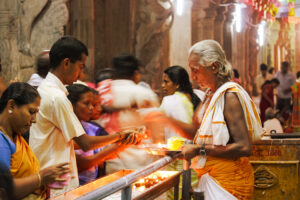
The public actively participates through sponsorship and donations, contributing to the temple’s prosperity. (iStock)
“In Vishnu temples, the day starts with Vishwaroopa Dharisanam, with milk. Following this, offerings, including curd rice, assorted rice dishes, milk, and fruits, grace the deity. Contrastingly, during pradosha vazhipadu in Shiva temples, the offerings consist of plain rice, honey, and vellam (jaggery). Interestingly, during Ekadasi and Amavasai at Vishnu temples, rice isn’t part of the offerings,” he explains.
Temple legends or sthala puranams too offer fascinating insights into the origins of neivedhyams and prasadams, notes Raghuram, peeling back the layers of history.
Consider, for instance, the mystical connection between Neyyappam — a delectable treat of rice pancakes fried in ghee — and the Appakkudathaan Perumal Temple in Thanjavur, steeped in centuries-old legend. And at the Kumbakonam Oppiliappan temple, where neivedhyams, including curd rice, sundal, and vadai, are prepared sans salt.
“Each preparation in these temple kitchens carries the weight of tradition and legend. While some traditions remain steadfast, others may fade with time, while some evolve to adapt to changing circumstances,” he concludes.
From the humble madapallis tended by dedicated staff to the grand rituals performed with utmost reverence, temples stand not only as spiritual sanctuaries but also as hubs of cultural exchange and gastronomic exploration. As modernisation and adaptation usher in new practices, and as the whispers of ancient legends mingle with the aromas wafting from temple kitchens, one truth remains constant — the ever-lasting connection between food, faith, and fellowship.
As for this storyteller, she eagerly anticipates her return to the Parthasarathy temple and its kitchen, eager to relish the flavours of its sojji appam once more!
For updates on Rakesh’s exploration of Sacred Offerings, visit Instagram @RakeshRaghunathan

Feb 29, 2024

Feb 22, 2024

Feb 07, 2024

Feb 07, 2024

Feb 06, 2024

Feb 06, 2024